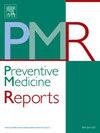美国成年人镁耗尽评分与高尿酸血症之间的潜在关联,基于NHANES 2003-2018的横断面研究。
IF 2.4
3区 医学
Q2 PUBLIC, ENVIRONMENTAL & OCCUPATIONAL HEALTH
引用次数: 0
摘要
目的高尿酸血症的病理生理机制需要对相关因素进行识别,以更好地了解疾病进展并开发有效的治疗方法。本研究旨在探讨镁消耗评分(MDS)与高尿酸血症之间的关系。方法横断面研究来源于2003-2018年全国健康与营养检查调查。高尿酸血症的定义是血清尿酸水平。结合影响肾镁重吸收的因素计算MDS。采用加权多变量logistic回归评估MDS与高尿酸血症之间的关系,并进行敏感性分析以确认稳健性。此外,使用限制性三次样条(RCS)和受试者工作特征(ROC)曲线分析进一步阐明两者之间的关系。结果与低MDS组(0-1)相比,中度MDS组(2)和高MDS组(3-5)的优势比(OR)和95%可信区间(CI)分别为1.76(1.52-2.04)和3.14(2.54-3.88)。RCS分析显示MDS和高尿酸血症之间呈线性剂量-反应关系。ROC分析显示MDS的曲线下面积为0.720 (95% CI, 0.717-0.721)。结论:本研究强调MDS与高尿酸血症风险之间存在密切关联,强调了解决高尿酸血症患者缺镁的重要性。本文章由计算机程序翻译,如有差异,请以英文原文为准。
Potential association between magnesium depletion score and hyperuricemia in American adults, a cross-sectional study based on NHANES 2003–2018.
Objective
The pathophysiological mechanisms underlying hyperuricemia necessitate the identification of contributing factors to better understand disease progression and develop effective therapies. This study aimed to investigate the association between Magnesium Depletion Score (MDS) and hyperuricemia.
Methods
A cross-sectional study was sourced from the National Health and Nutrition Examination Survey 2003–2018. Hyperuricemia was defined by serum uric acid levels. MDS was calculated by incorporating factors affecting renal magnesium reabsorption.Weighted multivariable logistic regression was employed to assess the association between MDS and hyperuricemia, with sensitivity analyses to confirm robustness. Additionally, Restricted Cubic Spline (RCS) and Receiver Operating Characteristic (ROC) curve analyses were used to further elucidate the relationship.
Results
Compared to the low MDS group (0–1), the odds ratios (OR) and 95 % confidence intervals (CI) for the middle MDS group (2) and high MDS group (3–5) were 1.76 (1.52–2.04), and 3.14(2.54–3.88), respectively. The RCS analysis illustrated a linear dose-response relationship between MDS and hyperuricemia. The ROC analysis demonstrated that MDS had an area under the curve of 0.720 (95 % CI, 0.717–0.721).
Conclusions
This study highlights a strong association between MDS and hyperuricemia risk, emphasizing the importance of addressing magnesium deficiency in hyperuricemic patients.
求助全文
通过发布文献求助,成功后即可免费获取论文全文。
去求助
来源期刊

Preventive Medicine Reports
Medicine-Public Health, Environmental and Occupational Health
CiteScore
3.90
自引率
0.00%
发文量
353
 求助内容:
求助内容: 应助结果提醒方式:
应助结果提醒方式:


